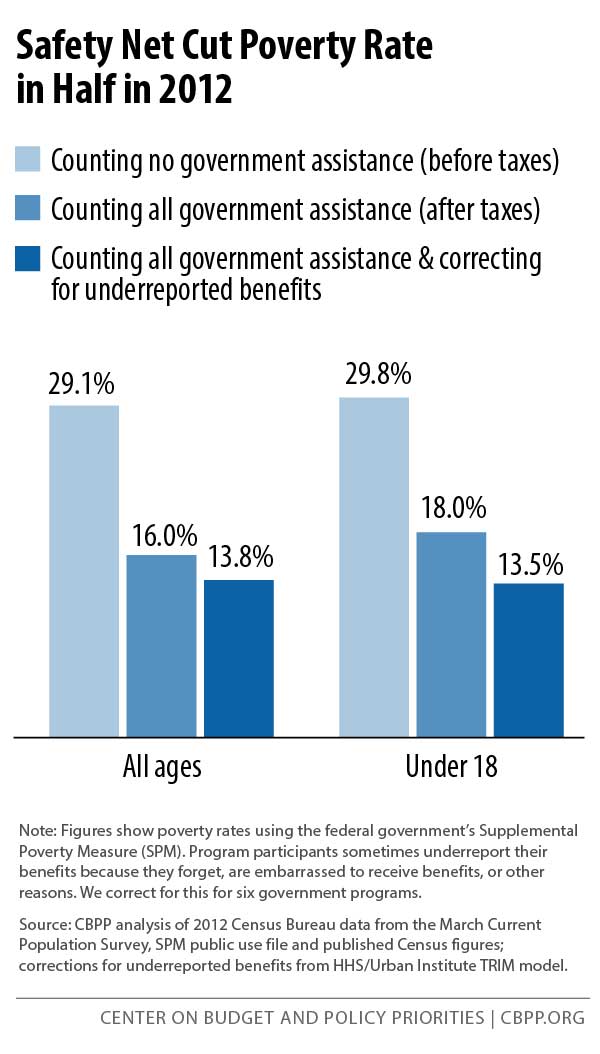Previous analysis of Census data showed that safety net programs cut the poverty rate nearly in half.[1] Data released recently by the Urban Institute, which correct for underreporting of key government benefits in the Census survey, reveal an even stronger impact: the safety net reduced the poverty rate from 29.1 percent to 13.8 percent in 2012 and lifted 48 million people above the poverty line, including 12 million children. (See Figure 1.) Correcting for underreporting reveals that the safety net also did more to reduce deep poverty than previously shown, although 11.2 million Americans remained below half the poverty line.
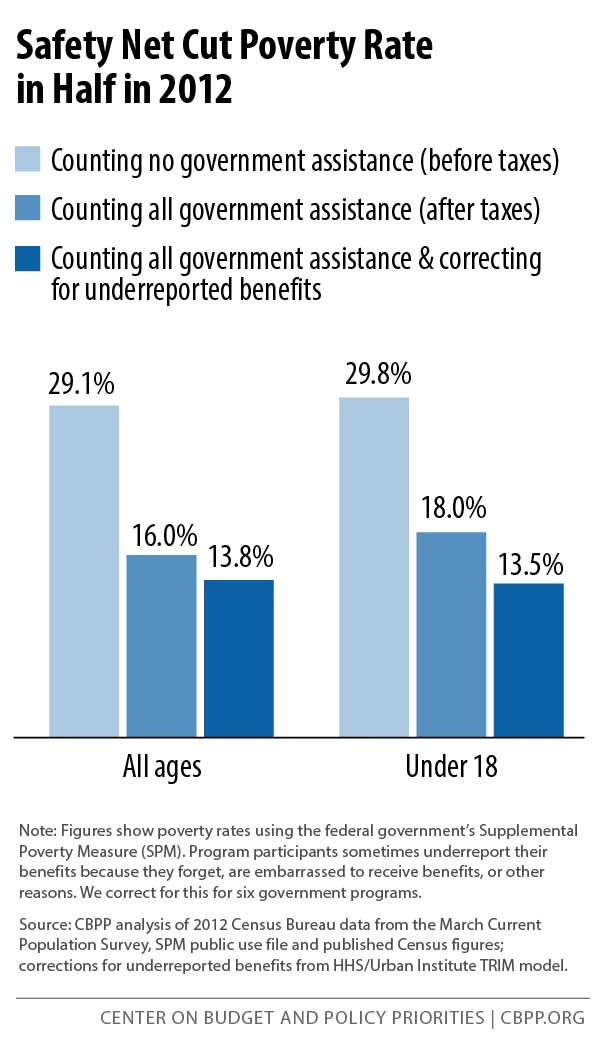 The appendix tables provide state-by-state data showing that the safety net lifted thousands out of poverty and deep poverty in every state, ranging from 61,000 in Wyoming to 4.9 million in California.
The appendix tables provide state-by-state data showing that the safety net lifted thousands out of poverty and deep poverty in every state, ranging from 61,000 in Wyoming to 4.9 million in California.
Social Security raises more Americans out of poverty than any other program: 27.4 million in 2012. Among programs limited to people with low or modest incomes, SNAP (formerly food stamps) has the greatest poverty-reducing impact, lifting 10.3 million people out of poverty in 2012. SNAP also lifts more Americans out of deep poverty (5.2 million) than any other means-tested program.
The refundable tax credits for low-income working families – the Earned Income Tax Credit (EITC) and the Child Tax Credit (CTC) – have an impact comparable to that for SNAP. Together they, too, lifted 10.3 million people out of poverty in 2012.
SNAP and the two working-family tax credits are especially important for children. The EITC and CTC lifted 5.3 million children out of poverty in 2012, while SNAP was close behind, lifting 4.9 million children out of poverty. SNAP also lifted more children out of deep poverty – raising 2.1 million children above half the poverty line – than any other program.
Correcting for Underreporting Reveals Stronger Safety Net
This analysis uses the Census Bureau’s Supplemental Poverty Measure (SPM), which, unlike the official poverty measure, counts government non-cash benefits such as food assistance and rent subsidies as income and subtracts from income various taxes paid, work expenses, and out-of-pocket medical expenditures. The SPM also makes other adjustments, such as using a poverty line that accounts for differences in living costs across the country.
This study goes beyond the SPM, however, by correcting for the underreporting in Census data of income from key forms of government assistance. Specifically, we use data for six programs from the TRIM microsimulation program designed and maintained by the Urban Institute. TRIM builds on Census data but adjusts it to more closely match actual program participation.[2]
This analysis focuses on 2012, the most recent year for which these corrections are available. (Because we lack comparable historical SPM data, we do not analyze trends over time.)[3]
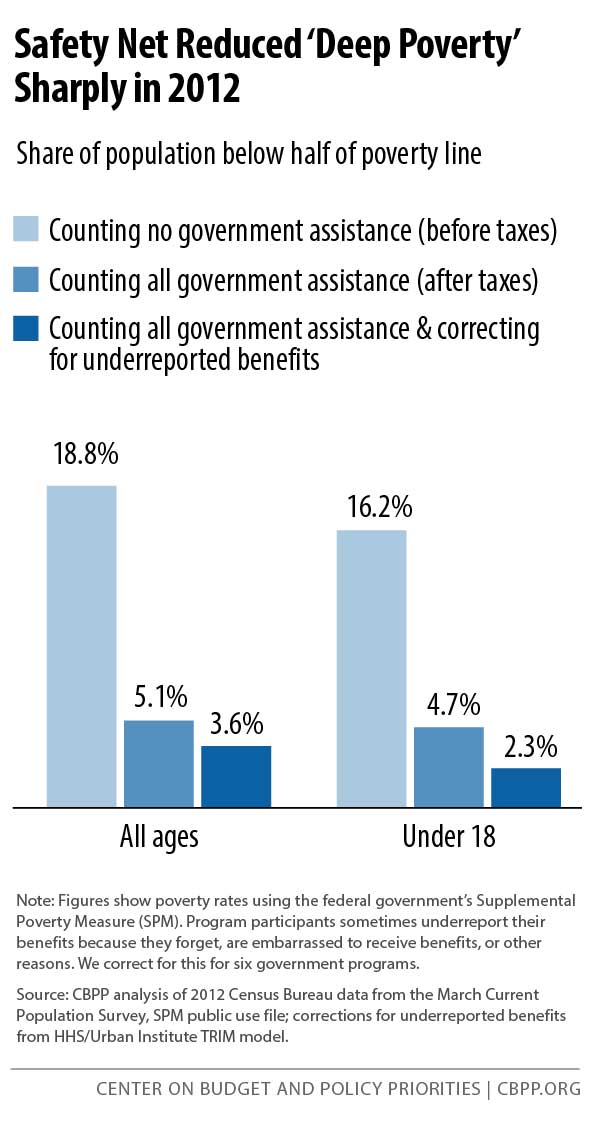 The poverty rate using the corrected data is 2.2 percentage points lower for all people, and 4.6 percentage points lower for children, than using the uncorrected SPM data, as Figure 1 shows. Using the corrected data has a particularly strong effect on deep poverty. The figures reveal that the safety net reduced the share of persons with family income below half of the poverty line to 3.6 percent, well below the 5.1 percent in the uncorrected data. (See Figure 2.) For children, the reduction is even more notable – to 2.3 percent, about half the 4.7 percent figure in the uncorrected SPM data.[4]
The poverty rate using the corrected data is 2.2 percentage points lower for all people, and 4.6 percentage points lower for children, than using the uncorrected SPM data, as Figure 1 shows. Using the corrected data has a particularly strong effect on deep poverty. The figures reveal that the safety net reduced the share of persons with family income below half of the poverty line to 3.6 percent, well below the 5.1 percent in the uncorrected data. (See Figure 2.) For children, the reduction is even more notable – to 2.3 percent, about half the 4.7 percent figure in the uncorrected SPM data.[4]
Even after these corrections, however, 11.2 million people remained below half the poverty line in 2012: 1.7 million children, 4.9 million adult women, and 4.6 million adult men. The greatest number by race or ethnicity were non-Hispanic whites (5.8 million), compared with 2.6 million Hispanics and 1.7 million non-Hispanic African Americans, reflecting the large size of the white population overall. Minorities, however, faced a substantially higher likelihood of living in deep poverty: 4.8 percent of Hispanics and 4.5 percent of non-Hispanic African Americans lived below half the poverty line, compared with 3.0 percent of non-Hispanic whites. (See Table 1.)
Living below half the SPM’s poverty line meant having income after non-cash benefits, taxes, and expenses for items like health care and child care of less than $12,523 for a family of four (a couple with two children) renting a home in an average-cost community in 2012. A comparison illustrates the difficulty of making ends meet at such a low income level. In 2012, 68 percent of four-person families spent more than that on food and transportation alone, an imbalance that could leave a family living in deep poverty in debt before it begins to pay for shelter, clothing, or other basic needs.
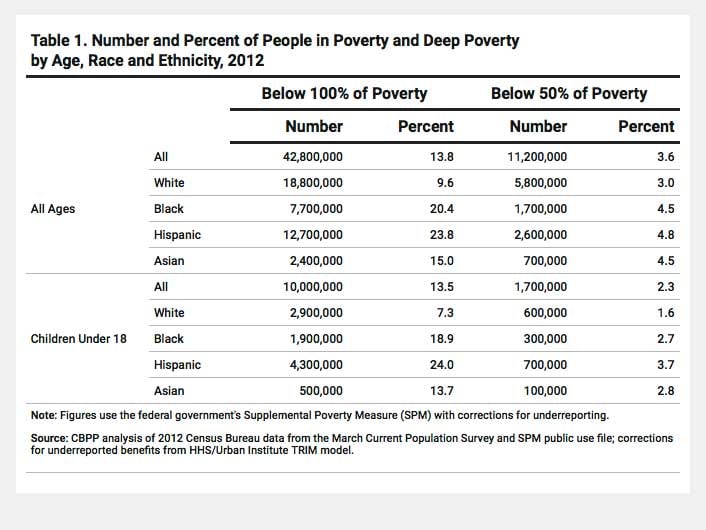
Which Programs Keep the Most People out of Poverty and Deep Poverty?
Social Security lifts more Americans out of poverty than any other program.[5] Using the corrected SPM, Social Security lifted 27.4 million Americans above the poverty line in 2012. This total includes 17.5 million seniors, who rely heavily on Social Security income in their retirement years. It also includes 1.6 million children, who may benefit from Social Security either directly (for example, by receiving the program’s survivor payments if a working parent has died) or indirectly (if a family member receives retirement, disability, or survivor benefits).
After Social Security, SNAP (the Supplemental Nutrition Assistance Program) and refundable tax credits for working families had the largest poverty-reducing impacts. SNAP lifted 10.3 million Americans above the poverty line in 2012, including 4.9 million children. [6] Similarly, the two refundable credits for low-income working families, the Earned Income Tax Credit and the Child Tax Credit, together lifted 10.3 million Americans – including 5.3 million children -above the poverty line.[7] (See Figure 3.)
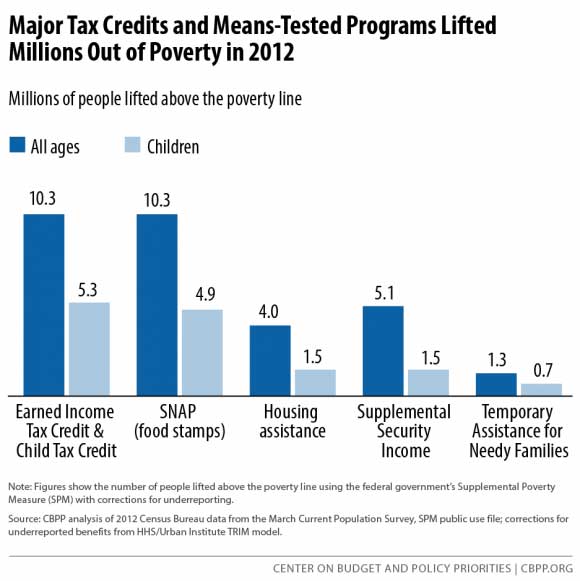
When “means-tested” income-support programs – those that limit assistance to people with low or modest incomes – are considered as a group, they lifted more than 27 million low-income Americans above the poverty line in 2012. These programs include SNAP, housing assistance, Supplemental Security Income (SSI) for low-income seniors and people with disabilities, cash assistance funded by Temporary Assistance for Needy Families (TANF), and the EITC and the low-income (or refundable) component of the Child Tax Credit.[8]
Housing programs reach relatively few eligible households due to limited funding but have strong antipoverty effects for those they do reach. In 2010, about 10 million Americans in 5 million low-income households received housing assistance,[9] well below the number that received other major programs means-tested programs like SNAP or the EITC.[10] Yet, housing assistance lifted out of poverty a larger share of those it assisted: 37 percent of housing assistance recipients would be considered poor without this assistance but were above the poverty line because of it.
Unemployment insurance (UI) lifted 2.7 million Americans above the poverty line in 2012. UI’s poverty-reducing effects rise in times of high unemployment, particularly when Congress provides additional UI benefits through emergency legislation. In 2009, a year in which unemployment soared and Congress provided additional UI benefits, unemployment benefits lifted more than 5 million Americans above the poverty line, almost twice as many as in 2012.
The safety net also plays a crucial role in easing deep poverty, particularly for families with children. In 2012, public tax and benefit policies overall reduced the number of children living below half the poverty line by 86 percent, or 10 million.[11] They reduced the number of children living below three-quarters of the poverty line by 75 percent, or nearly 13 million.
Social Security does more than any other single program to protect Americans from deep poverty, keeping 24.5 million people above half the poverty line in 2012, most of them elderly retirees. SNAP kept 5.2 million people above half the poverty line, including 2.1 million children under 18. As noted, SNAP also kept more children out of deep poverty than any other program in 2012. After Social Security and SNAP, SSI kept the most people of all ages out of deep poverty (4.2 million) in 2012. (See Figure 4.) UI lifted 1.3 million people, including 300,000 children above half the poverty line in 2012.

State-by-State Figures
The tax and benefit system lifted thousands of people above the poverty line in every state, ranging from 61,000 in Wyoming to 4.9 million in California. Not surprisingly, states with large overall populations had the largest numbers of people lifted out of poverty. (See the appendix tables for state-by-state data.)
The government tax and benefit system reduced poverty by more than half in 41 states. In West Virginia, for example, the poverty rate was 31.1 percent before taxes and benefits are counted, but 10.0 percent – less than one-third as much – once taxes and benefits are taken into account.
These state figures average together data for four years (2009-2012) for increased reliability. Unlike the nationwide figures, the state estimates use Census data instead of TRIM data for the Low Income Home Energy Assistance Program (LIHEAP) and the Special Supplemental Nutrition Program for Women, Infants, and Children (WIC) because TRIM data for those two programs are not consistently available before 2012.
Conclusion
The safety net protects millions of Americans from poverty and especially from deep poverty, with the numbers lifted out of poverty seen to be even larger after correcting for underreported income. Nonetheless, 42.8 million people remained below the SPM poverty line in 2012 even after the corrections, including 11.2 million people living below half the poverty line.
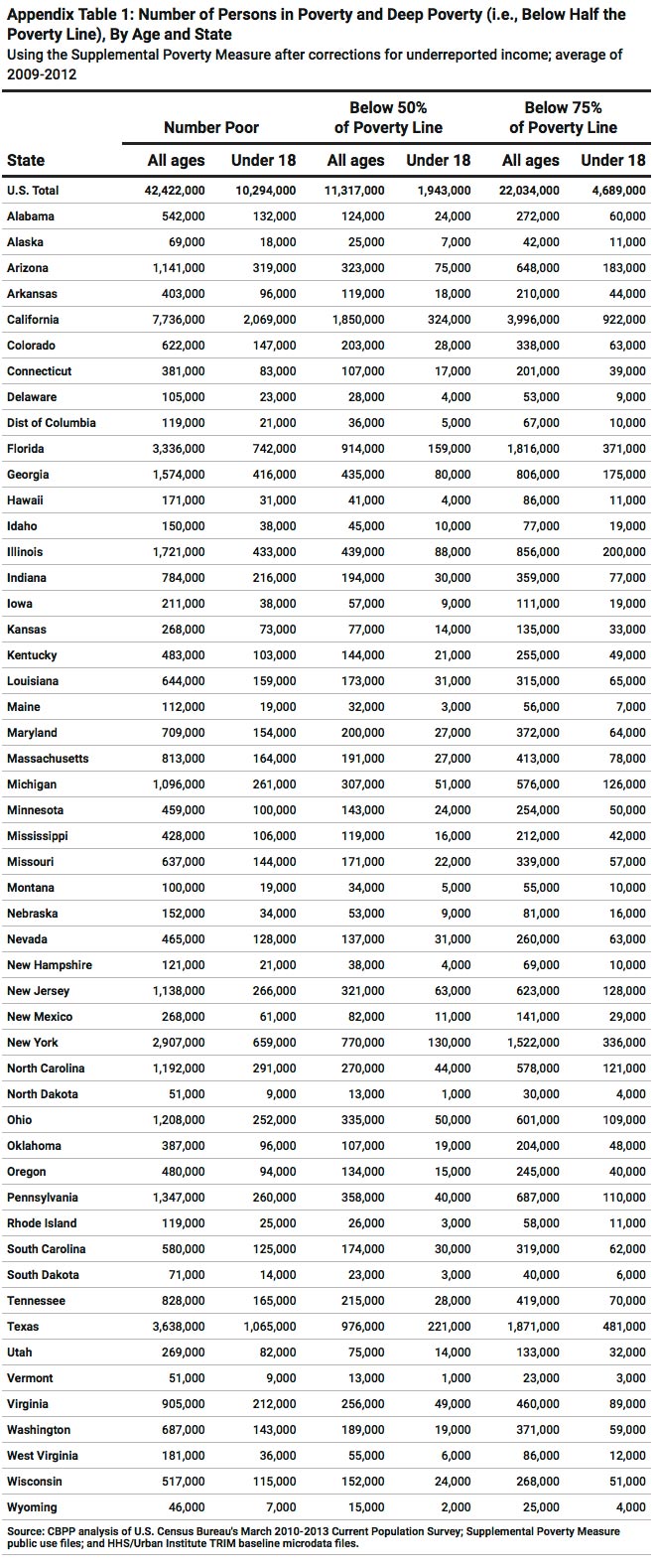

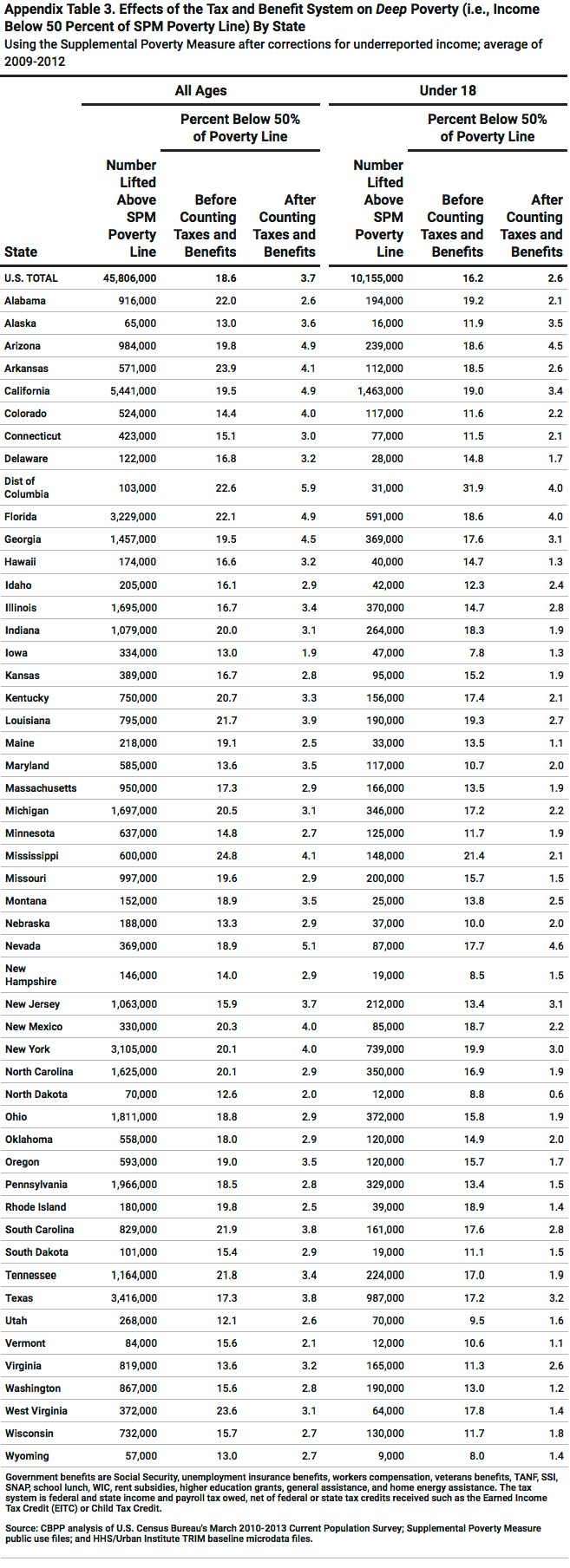
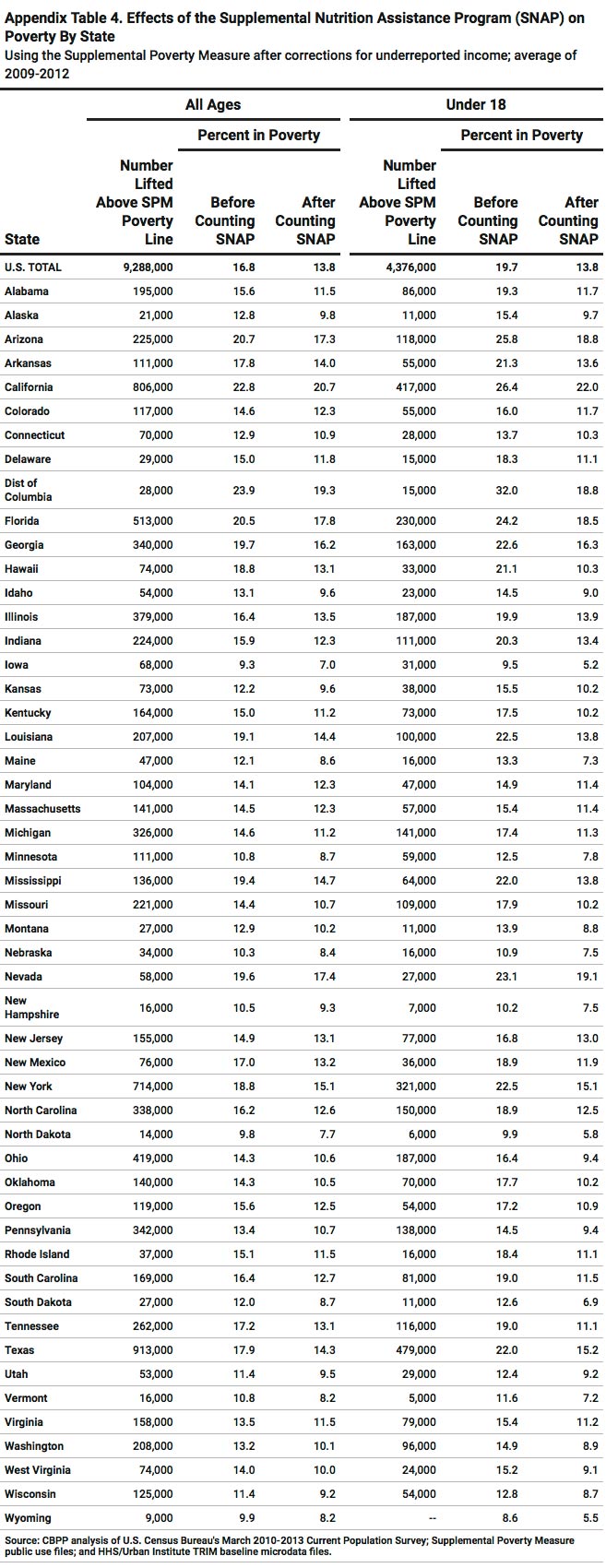
End Notes
[1] Danilo Trisi, “Safety Net Cut Poverty Nearly in Half Last Year, New Census Data Show,” Off the Charts blog, October 16, 2014, https://www.offthechartsblog.org/safety-net-cut-poverty-nearly-in-half-last-year-new-census-data-show/.
[2] We correct the well-known problem of income underreporting in the Census data for six government assistance programs: the Supplemental Nutrition Assistance Program (SNAP, formerly food stamps), Supplemental Security Income (SSI), housing assistance (such as rental vouchers and public housing), Temporary Assistance for Needy Families (TANF), the Special Supplemental Nutrition Program for Women, Infants, and Children (WIC), and the Low Income Home Energy Assistance Program (LIHEAP). The corrections use baseline data from the Transfer Income Model Version III (TRIM III) policy microsimulation model developed and maintained by the Urban Institute under contract with the Department of Health and Human Services’ Office of the Assistant Secretary for Planning and Evaluation. Like the SPM, TRIM starts with data from Census’ Current Population Survey but uses a different method of filling in questions skipped by survey respondents, in order to closely match actual numbers and characteristics of benefit recipients shown in program records.
[3] For an analysis of trends from 1995 to 2010 using TRIM corrections and a poverty measure similar to the SPM, see forthcoming paper by Arloc Sherman and Danilo Trisi, “Safety Net for Poorest Weakened After Welfare Law But Regained Strength in Great Recession, at Least Temporarily.”
[5] In this analysis, the number of people lifted out of poverty by a program is the difference between the number who would be poor before income from that program is counted (that is, counting income from all sources except that program) and the number poor after it is counted (that is, the actual number poor). For the safety net as a whole, poverty reduction is shown net of the effect of taxes (including federal payroll and state and federal income taxes), which can push income below the poverty line.
[6] These figures will differ from estimates based on other sources. For example, Census estimates using the SPM but not TRIM’s corrections for underreporting, show that SNAP reduced the poverty rate by 1.6 percentage points in 2012, or about 5 million people. With the corrections, our figures show SNAP reduced poverty by more than 10 million people. The difference chiefly reflects the importance of underreported SNAP in the Census data. TRIM counts $71 billion in SNAP payments for calendar year 2012, compared with $41 billion in the uncorrected Census data. (The TRIM total is similar to the actual benefit payments of $75 billion in U.S. Department of Agriculture records.) In addition, some SNAP families have income from SSI, TANF, and housing assistance that shows up in the TRIM data but not in the uncorrected Census data, which means they are less poor – and hence are more easily lifted the rest of the way above poverty by SNAP.
[7] By itself, the EITC lifted 6.7 million people (including 3.4 million children) above the poverty line in 2012 by our measure, while the CTC lifted 2.7 million people (including 1.4 million children) above the poverty line. The impact of the two tax credits together is slightly larger than the sum of their separate effects because it includes non-poor people who would be poor if one disregarded income from both credits (but not either credit separately).
[8] Other means-tested programs included in this total are WIC, LIHEAP, means-tested veterans’ benefits, free and reduced-price school lunch, Pell and other government higher education grants, and state General Assistance programs. (Other means-tested programs, such as Medicaid or child care subsidies, are not included because they are not considered income assistance or are not available from the Census data.)
[9] See “Policy Basics: Federal Rental Assistance,” Center on Budget and Policy Priorities, January 25, 2013,https://www.cbpp.org/research/policy-basics-federal-rental-assistance.
[10] In our data, about 62 million people in 2010 lived in families that received SNAP during the year. About 81 million lived in families with EITC income.
[11] In our analysis, figures for people in deep poverty (below 50 percent of the poverty line) exclude people in families with negative incomes (i.e., incomes below zero). Some of these families likely have substantial resources but report temporary business losses that take their income for the year into negative territory. The number of people in families with negative cash income is small compared with the U.S. population (about 178,000 such people in 2012, or 0.06 percent of the population) and has little effect on our estimates of people protected from poverty and deep poverty.
Our most important fundraising appeal of the year
December is the most critical time of year for Truthout, because our nonprofit news is funded almost entirely by individual donations from readers like you. So before you navigate away, we ask that you take just a second to support Truthout with a tax-deductible donation.
This year is a little different. We are up against a far-reaching, wide-scale attack on press freedom coming from the Trump administration. 2025 was a year of frightening censorship, news industry corporate consolidation, and worsening financial conditions for progressive nonprofits across the board.
We can only resist Trump’s agenda by cultivating a strong base of support. The right-wing mediasphere is funded comfortably by billionaire owners and venture capitalist philanthropists. At Truthout, we have you.
We’ve set an ambitious target for our year-end campaign — a goal of $250,000 to keep up our fight against authoritarianism in 2026. Please take a meaningful action in this fight: make a one-time or monthly donation to Truthout before December 31. If you have the means, please dig deep.
